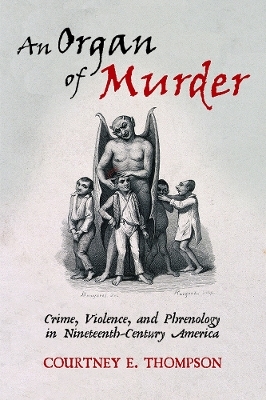
An Organ of Murder
Crime, Violence, and Phrenology in Nineteenth-Century America
Seiten
2021
Rutgers University Press (Verlag)
978-1-9788-1306-9 (ISBN)
Rutgers University Press (Verlag)
978-1-9788-1306-9 (ISBN)
Explores the origins of both popular and elite theories of criminality in the nineteenth-century US, focusing in particular on the influence of phrenology. This work traces the influence of phrenological visual culture and language in culture, law, and medicine, as well as the practical uses of phrenology in courts, prisons, and daily life.
Finalist for the 2022 Cheiron Book Prize
An Organ of Murder explores the origins of both popular and elite theories of criminality in the nineteenth-century United States, focusing in particular on the influence of phrenology. In the United States, phrenology shaped the production of medico-legal knowledge around crime, the treatment of the criminal within prisons and in public discourse, and sociocultural expectations about the causes of crime. The criminal was phrenology’s ideal research and demonstration subject, and the courtroom and the prison were essential spaces for the staging of scientific expertise. In particular, phrenology constructed ways of looking as well as a language for identifying, understanding, and analyzing criminals and their actions. This work traces the long-lasting influence of phrenological visual culture and language in American culture, law, and medicine, as well as the practical uses of phrenology in courts, prisons, and daily life.
Finalist for the 2022 Cheiron Book Prize
An Organ of Murder explores the origins of both popular and elite theories of criminality in the nineteenth-century United States, focusing in particular on the influence of phrenology. In the United States, phrenology shaped the production of medico-legal knowledge around crime, the treatment of the criminal within prisons and in public discourse, and sociocultural expectations about the causes of crime. The criminal was phrenology’s ideal research and demonstration subject, and the courtroom and the prison were essential spaces for the staging of scientific expertise. In particular, phrenology constructed ways of looking as well as a language for identifying, understanding, and analyzing criminals and their actions. This work traces the long-lasting influence of phrenological visual culture and language in American culture, law, and medicine, as well as the practical uses of phrenology in courts, prisons, and daily life.
COURTNEY E. THOMPSON is an assistant professor of the history of science and medicine and U.S. women’s history at Mississippi State University in Starkville. She received her Ph.D. from the program in the history of science and medicine of Yale University in 2015.
List of Illustrations
Acknowledgments
Introduction Through a Mirror, Darkly
1 Origins and Organs
2 Transatlantic Societies and Skulls
3 Phrenology on Trial
4 The Prison as Laboratory
5 Policing the Self and the Stranger
6 A Victory for Phrenology?
Epilogue Phrenological Futures
Notes
Bibliography
Inde
| Erscheinungsdatum | 22.01.2021 |
|---|---|
| Zusatzinfo | 18 b-w images |
| Verlagsort | New Brunswick NJ |
| Sprache | englisch |
| Maße | 152 x 229 mm |
| Gewicht | 397 g |
| Themenwelt | Studium ► Querschnittsbereiche ► Geschichte / Ethik der Medizin |
| Recht / Steuern ► Strafrecht ► Kriminologie | |
| Sozialwissenschaften ► Ethnologie | |
| Sozialwissenschaften ► Soziologie | |
| ISBN-10 | 1-9788-1306-6 / 1978813066 |
| ISBN-13 | 978-1-9788-1306-9 / 9781978813069 |
| Zustand | Neuware |
| Haben Sie eine Frage zum Produkt? |
Mehr entdecken
aus dem Bereich
aus dem Bereich
Die Geschichte eines Weltzentrums der Medizin von 1710 bis zur …
Buch | Softcover (2021)
Lehmanns Media (Verlag)
CHF 27,90
Krankheitslehren, Irrwege, Behandlungsformen
Buch | Softcover (2024)
C.H.Beck (Verlag)
CHF 55,90


